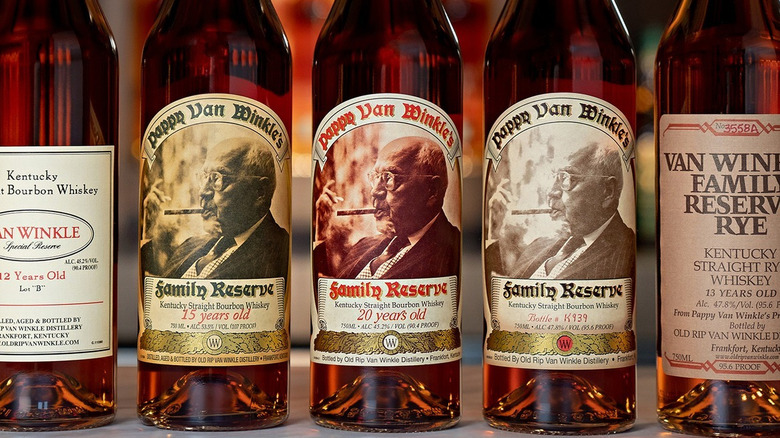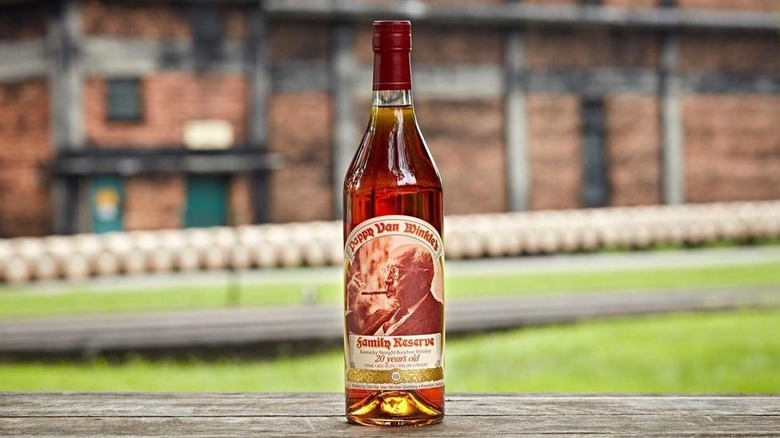Pappy Van Winkle 15 Vs 20 Vs 23: Which Is The Better Bourbon?
For lovers of bourbon, getting your hands on a bottle of Pappy, or even a glass of it, is an exciting experience. These whiskeys receive a huge amount of hype. That's partly due to their scarcity, but it mostly has to do with the quality of this fabled spirit. If you're interested in buying a bottle of Pappy Van Winkle, then you need to be sure you're getting the right whiskey for you. That's why I'm here to compare the three maturely aged bottles named after Pappy Van Winkle, who was a real person. As you'll see, the comparison goes far beyond just the age statement on the label.
As a longtime bourbon lover, I've had the pleasure of sampling these Pappy Van Winkle bottles. When added to the countless other bottles I've tasted, it gives me a perfect guide to judge just how good these expressions are. While price and availability play a big role in getting your hands on a bottle of Pappy, here I'll be judging them solely on tasting notes. With all that in mind, let's find out what makes these bourbons special, and which one deserves to be crowned as the best bottle of Pappy Van Winkle.
What is the Pappy Van Winkle line?
The six expressions from the Old Rip Van Winkle distillery can roughly be split into two categories. You have three bottles that come under the Pappy Van Winkle name, and three others named slightly differently. The latter expressions are the Old Rip Van Winkle 10 Year, Van Winkle Special Reserve 12 Year, and Van Winkle Family Reserve Rye 13 Year. Here, I'm focusing on the three maturely aged Pappy Van Winkle bourbons. If you're wondering just how good the other three are, check out my previous article featuring every Old Rip Van Winkle whiskey, ranked. The reason we are now looking at the three Pappy whiskeys is that they are the oldest and most prestigious of what the distillery offers.
The 15-, 20-, and 23-year-old Pappy Van Winkle bottles are hard to get your hands on at retail price. Often, you need to pay higher prices through secondary markets to claim one. Due to this, you need to know exactly what you're getting. There is a requirement for how long straight bourbon needs to be aged (at least two years), but finding bottles that are 10 years old or older is rare.
That extended aging is part of what gives these whiskeys their special appeal, as a huge amount of time, tradition, and craftsmanship has gone into them. Many see these expressions as the best bourbons in the world, but they all have significant differences that we'll explore here.
How we are taste testing Pappy Van Winkle
Sadly, I couldn't acquire all of these bottles at once for this taste test, as Pappy Van Winkle bourbon is rare even in the best of times. Thankfully, I have previous experience with these bottles, and as a bit of a whiskey nerd, I keep a personal record of all the whiskeys I've tried. However, while my personal experience influenced the verdict here, I've also leaned on other sources to get a more subjective and rounded view about which of these bottles comes out on top.
These sources include other Tasting Table writers, family members who have tasted Pappy, and a mix of reviews from enthusiasts and experts. With this huge bank of knowledge, I can deliver a fair and honest assessment of the Pappy Van Winkle line. As you'll see, age isn't everything, and there's a lot more to these bottles than older automatically being better. By the end, you should have useful insight into which of these bottles should be on top of your whiskey wish list.
Taste test: Pappy Van Winkle 15 Year
This whiskey is loved by bourbon aficionados around the globe, and for good reason. From the moment you pour it into your glass, you'll get to enjoy its rich smell. A mixture of wild berries and cherry gives it a fruity opening and mixes with a subtle woodiness that, when added to its sweeter tones, gives you a bouquet of stimulating aromas. The nose is a curious aspect of whiskey, as it doesn't automatically relate to the all-important flavor but adds much to the overall experience. Thankfully, this is a bourbon that tastes even better than it smells.
As with all of these expressions, you'll get to enjoy a velvety mouthfeel that is common for such maturely aged spirits. Caramel and vanilla —two of the most common tasting notes for bourbon — are beautifully showcased here, but you'll get to pick out many more subtle flavors.
I found some layers of chocolate and nuttiness, along with a few other earthy notes. These flavors sit on a bed of mild spicy notes to give the drink a robust foundation. That's supported by a fairly high proof of 107, which gives it plenty of power. Oak can dominate mature bourbons, but that doesn't happen here; instead, it sits pleasantly in the background. The smooth mouthfeel helps to give it a long finish that ends with satisfying warmth. All the bourbons highlighted here are excellent, and this expression stands up well to its older siblings.
Taste test: Pappy Van Winkle 20 Year
With an extra five years of aging, this expression takes much of what you'll find in the 15 Year Pappy to the next level. If you leave a bourbon in a barrel for too long, it can get what some call over-oaked. This means that the barrel has influenced the flavor too much, and oak completely dominates the palate. Six to 12 years was often considered the sweet spot for aging bourbon, but Pappy bottles somehow go way beyond this figure while still producing balanced whiskey.
The 20 Year is the best example of that. The wood smell on the nose is present but not dominant. Along with the oak, you'll get a nice hit of spice and many of the fruity notes also found on the 15 Year.
On the palate you'll get some mellow toasted oak with all the beautiful smells on the nose carrying through to the palate. Added to these is some caramelized sugar and an elegant hit of vanilla. Throw in some cocoa, smokiness, and leather, and you have an expression with a tremendous amount of depth. All of these flavors are perfectly balanced, and it feels like you'll find something new with each sip. It gives you a great exploration of whiskey, and allows you to marvel at how good a bourbon can be. With a proof of a little over 90, this is an easy-sipping whiskey that anyone can enjoy.
Taste test: Pappy Van Winkle 23 Year
Of the three expressions from this brand, Pappy Van Winkle 23 is the one that most divides opinion. Even though it's just three years older than the 20 Year, this Pappy has a much more notable oak influence. I personally love whiskeys that have earthy tasting notes, but not everyone does.
That being said, this is still an exceptional bourbon that should be on any enthusiast's whiskey bucket list. The aroma brings out a beautifully rich caramel balanced out by the expected wooden notes. More aromas come in the form of an earthy smoke and nuttiness, while also having a lovely range of fruits.
As mentioned, the oak here has a powerful influence on the palate, especially initially. However, as you let the whiskey sit in your mouth for a second, many other tasting notes open up. The caramel sweetness from the nose is present and joined by powerfully rich vanilla. There is a touch of spice there, but it's only mild, and you'll get to enjoy some chocolate and cherry to complete a unique tasting experience.
The finish contains plenty of oak, but is also sweeter than many other bourbons. All of these notes sit in the bourbon's elegant and smooth texture, which gives you the final indicator that you're tasting an elite bourbon. It's probably the most unique of the three, but that could be a good or bad thing, depending on your personal tastes.
The verdict
If you asked a group of Pappy fans to list their favorite bottle, you'd likely find all three of these whiskeys ranked at number one on different lists. Ultimately, a lot comes down to personal preference. The 15 Year has the highest proof and packs more of a punch. If you like bourbons that can put some fire into your soul, this could well be your favorite.
The 20 Year is perfectly balanced, and has a softer proof for a more refined drinking experience. It allows you to savor the nuances of the whiskey without any single tasting note dominating the palate. The 23 Year has a more earthy quality, but compared to most other bourbons, it is still incredibly complex and balanced. It offers a diverse range of flavors with a powerful tasting profile. This is an understandable favorite for those who like a heavier oak influence.
In my eyes, the Pappy Van Winkle 20 Year takes the crown. It has all the qualities of both the 15 Year and 23 Year, while also delivering its own unique tasting notes. It still has plenty of power to tick all the boxes for what makes an exquisite bourbon. But as I've mentioned, we all have different palates, and your favorite may differ. Hopefully, I've equipped you with all the knowledge you need to find your next bottle of Pappy. One thing is clear: whether it's the 15-, 20-, or 23-year-old expression, there are no bad choices here.






